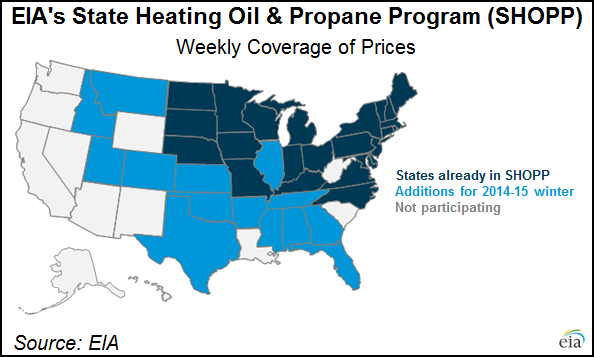EIA Expands Heating Oil, Propane Price Data Program to 38 States
The U.S. Energy Information Administration (EIA) said it is expanding its program for collecting weekly residential heating oil and propane price data from 24 to 38 states this winter.

In a “Today in Energy” note Thursday, the EIA said its State Heating Oil and Propane Program (SHOPP) has traditionally included 24 states in the Northeast and Midwest regions, but after last winter’s polar vortex an additional 14 states expresses interest in joining the program.
Starting Thursday and continuing through March, the EIA will publish residential heating oil and propane prices in 14 new states: Alabama, Arkansas, Colorado, Florida, Georgia, Idaho, Illinois, Kansas, Mississippi, Montana, Oklahoma, Tennessee, Texas and Utah.
The agency will also publish aggregate propane prices for the six states that comprise the Gulf Coast region (Alabama, Arkansas, Louisiana, Mississippi, New Mexico and Texas) and the five states in the Rocky Mountain region (Colorado, Idaho, Montana, Utah and Wyoming).
According to the EIA, the addition of 14 more states to SHOPP will increase the program’s coverage of households that use propane as a heating fuel, from 56% to 85%. That figure is based on data from the U.S. Census Bureau’s American Community Survey.
“Unlike retail natural gas and electricity, which are both provided through utility companies, retail heating oil and propane are sold by independent dealers,” the EIA said. “Dealers and their customers face considerable supply and price uncertainty, such as during this past winter when extreme weather drove up demand for heating fuels, depleting inventories and increasing prices. SHOPP provides valuable information to customers, fuel providers, and state officials about market conditions.”
The EIA also created a “Winter Heating Fuels” website to show information at the state level. The website will display weekly price data on heating oil and propane in the 38 participating states, as well as natural gas and electricity prices and supply.
Last week, the EIA projected that U.S. households should expect lower heating bills this winter compared to last, thanks in large part to less severe temperatures, but also due to lower natural gas spot prices and significantly higher winter gas production (see Daily GPI, Oct. 7).
© 2024 Natural Gas Intelligence. All rights reserved.
ISSN © 1532-1231 | ISSN © 2577-9877 |
